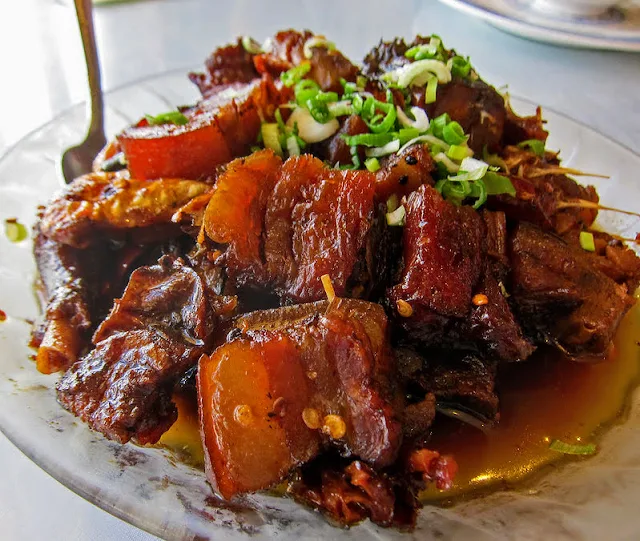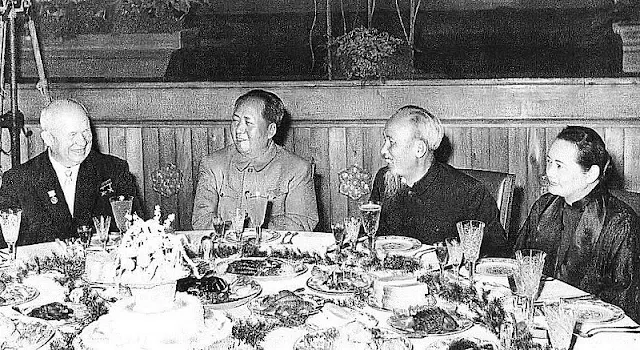Hunan cuisine 湖南菜 is also known as Xiang cuisine 湘菜 because the Xiang Jiang river runs through the south central Chinese province. Hunan cuisine is one of the eight major cuisines of China which includes Cantonese, Jiangsu, Anhui, Fujian, Shandong, Sichuan and Zhejiang cuisines.
Hunan cuisine is known for its greasiness, vibrant colours and robust spicy, sour and savoury-salty flavours. The main cooking techniques are stewing, stir frying, deep frying and steaming.
Xiang Jiang river is a tributary of the Yang Tze river that runs through the centre of landlocked Hunan province. Xiang Jiang river and Dongting lake 洞庭湖 supply the fresh aquatic life for Hunan cuisine. Hunan literally means "south of the lake" i.e. Dongting lake.
The capital of Hunan province, Changsa city is located at the banks of Xiang Jiang river. Changsa city has a population of over 10 million in 2020. Hunan province has a population of over 66 million.
One of the signatures of Hunan cuisine is its spiciness. There's a saying "Jiangxi people are not afraid of spicy food, Sichuan people do not fear spicy food, Hunan people fear non spicy food".
Hunan province is sandwiched between great water bodies such as Dongting lake to its north and 雪峰山脉 Xuefeng mountain range to its southwest. Hunan summers are wet and hot while winters are cold and wet. The excessive year round humid / wet (yin) climate may have long driven Hunan people to develop a penchant for extra heat (yang) from black pepper, chili peppers and other hot spices in their food. Spicy food is believed to drive excess moisture from the body.
Spiciness is not a flavour but a sensation. Our taste buds can only detect sour, sweet, bitter, and saltiness. Spiciness stimulate our nerves in the lips and tongue rather than the taste buds. It also warms our body.
Hunan people have been using black pepper in their cuisine since the Han dynasty (202 BC - 220 AD). When chili peppers arrived in Hunan via India in the 1500s, Hunan people fully embraced the hot spice. Five hundred years on, chili pepper is an indispensable part of Hunan cuisine.
When you visit a fresh vegetable market in Hunan, you will see locally grown chili pepper. But, as Hunan people eat more chili than their own province can produce, you will also see all kinds of chili peppers imported from other provinces and even from overseas.
In almost every Hunan home, you will find bottles or jars of chopped chili which they eat with almost everything. The chopped chili condiment is made by pounding chopped raw fresh chili pepper. It is then sprinkled with salt and left to ferment. The fermented pounded, chopped chili pepper taste slightly sour, sweet and, of course, spicy.
红烧肉 Braised Pork is one of the most famous of Hunan dishes. It is made with cubes of streaky pork cut from the pig's belly with 5 layers - fat, lean, fat, lean, and skin.
The streaky 5-layer pork belly is first deep fried in 150℃ oil to remove excess grease. The deep fried pork is then stir fried with ginger, chili pepper, garlic, star anise, cinnamon, etc. The pork belly is then stewed in the spicy sauce till it is silky soft like a juicy curd.
Of course, stewed pork belly is found throughout China. The Hunan rendition differs from their other province counterparts (e.g. like Zhejiang's Dongpo Rou) by being less savoury-salty and less sweet. Hunan braised pork belly instead emphasise spice flavours and aroma.
Hunan stewed pork belly is one of the favourite dishes of Mao Tse Tung who is a Hunan native.
Steamed Fish Head with Chopped Chili is another representative Hunan dish. The cleaned carp fish head is marinated in a sauce of cooking wine, salt, spring onion, ginger. Next, the dressing sauce is prepared by frying garlic, fermented black beans, spring onion, and lots of chopped chili pepper in hot oil. Blanket the whole marinated fish head with the dressing sauce of chopped chili, etc. Final dressing is chopped, raw chili pepper. Steam the fish head for 18 minutes and it is ready to serve.
When the fish head is served, all you see is a fiery red blanket of chopped chili pepper. The huge fish head is almost invisible. The steamed fish meat is soft and smooth, especially the gelatinous tissue in the bone crevices and mouth. A bit of mild spiciness may infuse the meat but it is bearable for most people. If you like your mouthful of fish to be more spicy, simply include a bit of the chopped chili in your spoonful.
Spicy dishes dominate Hunan cuisine but not all Xiang dishes are spicy. One famous non spicy Hunan dish is stinky tofu. There are a few variations of stinky tofu depending on the province it comes from. Changsa city has its own unique version.
Bricks of tofu are marinated in a dark sauce of fermented bamboo shoot, soy bean, etc. The fermented tofu is then deep fried till it is crisp outside. When served, the fried fermented tofu has a signature "stinky" smell which is an acquired taste. Once you sink your teeth past the crispy outside, the tofu inside is soft and juicy sweet. Changsa style stinky tofu is a Must have side dish in Hunan restaurants.
Besides been a side dish, stinky tofu can also be used as an ingredient in main dishes such as in stewed pork knuckles, etc.
Written by Tony Boey on 1 Aug 2021References:
Image of spicy fish courtesy of flickr. Image of stewed pork courtesy of flickr. Image of Xuefeng mountains courtesy of Max Pixel. Image of man chopping chili pepper courtesy of Wikipedia. Image of Mao Tse Tung courtesy of Wikipedia. Image of Hunan chili pepper courtesy of Wikipedia. Image of Changsa city courtesy of Wikipedia. Image of Xiang River courtesy of Wikipedia. Image of stewed pork courtesy of screengrab from CCTV 4 video 湘菜. Image of Human cuisine courtesy of flickr. Image of stinky tofu courtesy of Wikipedia.













No comments:
Post a Comment
All comments submitted with genuine identities are published